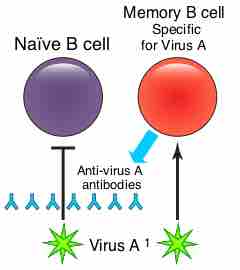B Cell Maturation
Introduction
B cells are lymphocytes that play a large role in the humoral immune response (as opposed to the cell-mediated immune response, which is governed by T cells) . The principal functions of B cells are to make antibodies against antigens, perform the role of antigen-presenting cells (APCs), and eventually develop into memory B cells after activation by antigen interaction. B cells are an essential component of the adaptive immune system.

B cell
B cells are the cells of the immune system that make antibodies to invading pathogens like viruses. They form memory cells that remember the same pathogen for faster antibody production in future infections.
Immature B cells are produced in the bone marrow of most mammals. After reaching the IgM+ immature stage in the bone marrow, these immature B cells migrate to secondary lymphoid tissues (such as the spleen, lymph nodes, Peyer's patches, etc.) where they are called transitional B cells, and some of these cells differentiate into mature B lymphocytes.
Maturation Process
B cell development occurs through several stages, each stage representing a change in the genome content at the antibody loci. An antibody is composed of two identical light (L) and two identical heavy (H) chains, and the genes specifying them are found in the 'V' (Variable) region and the 'C' (Constant) region. In the heavy-chain 'V' region there are three segments; V, D, and J, that recombine randomly, in a process called VDJ recombination, to produce a unique variable domain in the immunoglobulin of each individual B cell. Similar rearrangements occur for light-chain 'V' region except there are only two segments involved; V and J.
When the B cell fails in any step of the maturation process, it will die by a mechanism called apoptosis, or specifically, clonal deletion. B cells are continuously produced in the bone marrow. When the B cell receptor, on the surface of the cell matches the detected antigens present in the body, the B cell proliferates and secretes a free form of those receptors (antibodies) with identical binding sites as the ones on the original cell surface. After activation, the cell proliferates and B memory cells would form to recognize the same antigen. This information would then be used as a part of the adaptive immune system for a more efficient and more powerful immune response for future encounters with that antigen.
Like their fellow lymphocytes, the T cells, immature B cells are tested for auto-reactivity by the immune system before leaving the bone marrow. In the bone marrow (the central lymphoid organ), central tolerance is produced. The immature B cells whose B-cell receptors (BCRs) bind too strongly to self antigens will not be allowed to mature. If B cells are found to be highly reactive to self, three mechanisms can occur.
Further Differention
The human body makes millions of different types of B cells each day that circulate in the blood and lymphatic system performing the role of immune surveillance. They do not produce antibodies until they become fully activated. Each B cell has a unique receptor protein (referred to as the B cell receptor (BCR)) on its surface that will bind to one particular antigen. The BCR is a membrane-bound immunoglobulin. It is this molecule that allows the distinction of B cells from other types of lymphocyte, as well as being the main protein involved in B cell activation. Once a B cell encounters its cognate antigen and receives an additional signal from a T helper cell, it can further differentiate into either plasma B cells or memory B cells. The B cell may either become one of these cell types directly or it may undergo an intermediate differentiation step, the germinal center reaction, where the B cell will hypermutate the variable region of its immunoglobulin gene ("somatic hypermutation") and possibly undergo class switching. Other functions for B cells include antigen presentation, cytokine production, and lymphoid tissue organization.
B cells exist as clones. All B cells derive from a particular cell, and thus, the antibodies their differentiated progenies produce can recognize and/or bind the same specific surface components composed of biological macromolecules (epitope) of a given antigen. Such clonality has important consequences because immunogenic memory relies on it. A single B cell or a clone of cells with shared specificity, upon encountering its specific antigen, divides to produce many B cells. Most of such B cells differentiate into plasma cells that secrete antibodies into blood that bind the same epitope that elicited proliferation in the first place. A small minority survives as memory cells that can recognize only the same epitope.
With each cycle, the number of surviving memory cells increases. The increase is accompanied by affinity maturation, which induces the survival of B cells that bind to the particular antigen with high affinity. This subsequent amplification with improved specificity of immune response is known as secondary immune response. B cells that encounter antigen for the first time are known as naive B cells.